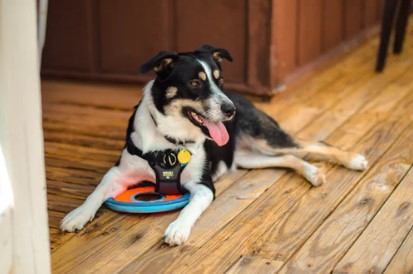Diabetic Alert Dogs Better Than Tech Tools
 With type 1 diabetes there is the endless monitoring of blood sugar levels, even at night, which can leave you sleep-deprived and add to an already stressful existence. Service dogs can be trained to sniff out unhealthy blood sugar levels in humans — and alert them 20 minutes before a glucose monitoring system can. This is very important because low blood sugar can result in a coma; high blood sugar over an extended period of time can lead to kidney, liver, eye damage or stroke. If proper measures are not taken, high and low blood glucose levels can lead to death. Amazingly, service dogs can be trained to alert diabetics before they are in serious danger. Humans have about 5 million nose receptors while dogs have about 250 million.
With type 1 diabetes there is the endless monitoring of blood sugar levels, even at night, which can leave you sleep-deprived and add to an already stressful existence. Service dogs can be trained to sniff out unhealthy blood sugar levels in humans — and alert them 20 minutes before a glucose monitoring system can. This is very important because low blood sugar can result in a coma; high blood sugar over an extended period of time can lead to kidney, liver, eye damage or stroke. If proper measures are not taken, high and low blood glucose levels can lead to death. Amazingly, service dogs can be trained to alert diabetics before they are in serious danger. Humans have about 5 million nose receptors while dogs have about 250 million.
A 3-year-old girl in Texas who suffers from a rare form of infant diabetes wouldn’t be alive today if she didn’t have a diabetic alert dog. The little girl’s mother says their Diabetic alert service dog saved her daughter’s life on numerous occasions.
A diabetic alert dog became 3-year-old Faith’s constant companion. She has been a Type 1 Diabetic since she was 9 months old, and wouldn’t be alive without her service dog Ruby. Ruby is trained to detect drops in blood sugar levels, and Faith’s condition causes her blood sugar to reach dangerous levels up to 30 times each day. Ruby’s powers of detection are remarkable: the first night she spent with her new family, she alerted four times, saving Faith’s life.
Human noses can detect extremely high or extremely low blood sugar levels. High levels cause a sweet, fruity odor. With low blood sugar, the diabetic gives off an acetone smell similar to the odor of fingernail polish.
But diabetic service dogs can sniff out very subtle fluctuations in blood glucose levels and can be trained to alert the diabetic even if his blood sugar is within normal range but dropping.
When a trained Diabetic Service dog detects an imbalance, it will alert the diabetic by performing one or more various actions such as licking, nudging or barking. The Service Dog may also be trained to retrieve juice boxes, medicine or testing supplies. In a worst-case scenario, if the diabetic is unconscious, the service dog can be trained to call 911 on a special device that will leave a pre-recorded message informing emergency personnel that a diabetic incident has occurred.
Kitty was 6 when she was diagnosed with type 1 diabetes and went to have 2-3 seizures a week to having NONE in 3 and 1/2 years after getting her diabetic alert service dog Teddy from Wild Rse Kennels. The demand for these life saving diabetic service dogs is on the rise and trainers can’t keep up with the demand for them.
